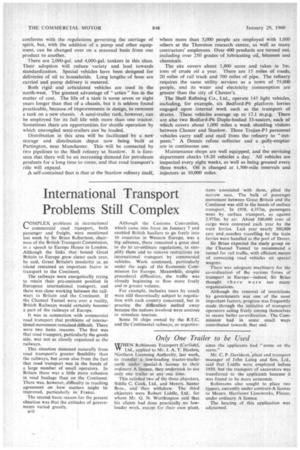International Transport Problems Still Complex
Page 44

If you've noticed an error in this article please click here to report it so we can fix it.
r0MPLEX problems in international
commercial road transport, both passenger and freight, were mentioned last week by Sir Brian Robertson, chairman of the British Transport Commission, in a speech to Europe House in London. Although the links that bound Great Britain to Europe grew closer each year, he said, Great Britain's insularity as an island remained an important factor in transport to the Continent.
The railways were energetically trying to retain their pre-eminent position in European international transport, and there was close working between the railways in Britain and the Continent. If the Channel Tunnel were ever a reality, British Railways would certainly become' a part of the railways of Europe. It was in connection with commercial road transport that problems of interne.. tional movement remained difficult There were two basic reasons. The first was that road transport, particularly the goods side, was not. as closely organized as the railways. This situation stemmed naturally from road transport's greater flexibility than the railways, but arose also from the fact that road transport was in the hands of a large number of small operators. In Britain there was a little more cohesion in road haulage than on the Continent. There was, however, difficulty in reaching agreement on how matters might be improved, particularly in France. The second basic reason for the present situation was that the attitudes of governments varied greatly.
B I 0
Although the Customs Convention, which came into force on January 7 and enabled British hauliers to go freely into 10 countries in Western Europe, was a big advance, there remained a great deal to do to co-ordinate regulations, to simplify them and to remove restrictions on international transport by commercial vehicles. Work continued, particularly under the aegis of the Economic Commission for Europe. Meanwhile, despite procedural difficulties, the traffic was already beginning to flow more freely and in greater volume. For example, inclusive tours by coach were still theoretically subject to negotiation with each country concerned, but in practice the difficulties, melted away because the nations involved were anxious to stimulate tourism. Some 50 ships owned by the B.T.C. and the Continental railways, or organiza tions associated with them, plied the narrow seas. The bulk of passenger' movement 'between Great Britain and the Continent was still in the hands of surface transport. In 1958, 4.357m. passengers went by surface transport, as against 2.975m. by air. About 500,000 tons of cargo were conveyed each year by the train' ferries. Last year nearly 300,000 cars and coaches travelling by the train ferries were handled at the port of Dover. Sir Brian expected the study group on the Channel Tunnel to recommend a tunnel for rail traffic, with efficienkmeans of conveying road vehicles on special wagons. There was adequate machinery for the co-ordination of the various forms of transport in Europe—indeed, Sir Brian thought there were too many organizations. Although the removal of restrictions by governments was one of the most important factors, progress was frequently made through the initiative of transport operators acting freely among themselves to secure better co-ordination. The Commission had in some small ways contributed towards that end.






































































































